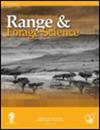热带稀树草原生态系统牧草产量、放牧能力和植物多样性的空间变异
IF 1.9
4区 环境科学与生态学
Q3 ECOLOGY
引用次数: 1
摘要
为了提高反刍家畜的生产,对牧场的评价必须成为一项常规工作。牧场评价提供了有关植被结构、生物量产量和质量的信息。加纳的几内亚稀树草原缺乏对牧草产量和质量的空间变异性特征的研究。假设加纳几内亚稀树草原牧草产量、放牧能力和植物多样性存在空间异质性。目的是评估加纳几内亚大草原牧草生产的空间结构和放牧能力,以促进可持续畜牧业生产。从105个采样点收集数据,并将其整合到地质统计学中,利用普通克里格插值法估算牧草产量和放牧能力。牧草产量和放牧能力分别为0.63 ~ 13.43 t ha - 1和0.18 ~ 3.79 LU ha - 1。牧草产量的均方根误差和平均标准误差接近,放牧量的均方根误差分别为2.38和2.51,放牧量的均方根误差分别为0.67和0.71。Shannon’s物种多样性指数为1.13 ~ 2.40。加纳-几内亚热带稀树草原牧草产量、放牧能力和物种多样性存在空间异质性,部分地区需要采取有效的因地制宜的改良策略来实现畜牧业的可持续生产。本文章由计算机程序翻译,如有差异,请以英文原文为准。
Spatial variability of herbage yield, grazing capacity and plant diversity in a tropical savannah rangeland ecosystem
To improve ruminant livestock production, evaluation of rangelands must be a routine. Rangeland evaluation gives information about the vegetation structure, biomass yield and quality. The Guinea savannah rangelands of Ghana lack research that characterises the spatial variability of herbage yield and quality. It was hypothesised that there is spatial heterogeneity in herbage yield, grazing capacity and plant diversity in the Guinea savannah rangelands of Ghana. The objective was to evaluate the spatial structure of herbage production and grazing capacity in the Guinea savannah rangelands of Ghana for sustainable livestock production. Data were collected from 105 sampling sites and integrated into geo-statistics, using ordinary kriging interpolation to generate herbage yield and grazing capacity estimates. Herbage yield and grazing capacity ranged from 0.63 t ha−1 to 13.43 t ha−1 and 0.18 LU ha−1 to 3.79 LU ha−1 respectively. The root mean square error and the average standard error values were close (2.38 and 2.51 respectively for herbage yield and 0.67 and 0.71 respectively for grazing capacity). Species diversity using the Shannon’s index ranged from 1.13 to 2.40. There was spatial heterogeneity in herbage yield, grazing capacity and species diversity in Ghana’s Guinea savannah rangelands with some parts needing effective site-specific improvement strategies for sustainable livestock production.
求助全文
通过发布文献求助,成功后即可免费获取论文全文。
去求助
来源期刊

African Journal of Range & Forage Science
ECOLOGY-ENVIRONMENTAL SCIENCES
CiteScore
4.00
自引率
14.30%
发文量
35
审稿时长
>12 weeks
期刊介绍:
The African Journal of Range & Forage Science is the leading rangeland and pastoral journal in Africa. The Journal is dedicated to publishing quality original material that advances rangeland ecology and pasture management. The journal aims to publish research of international importance from any region, but as an African journal, we are particularly interested in research from Africa and relevant to the continent. The Journal promotes both science and its application and authors are encouraged to explicitly identify the practical implications of their work. Peer-reviewed research papers and research notes deal primarily with all aspects of rangeland and pasture ecology and management, including the ecophysiology and biogeochemistry of rangelands and pastures, terrestrial plant–herbivore interactions (both domestic and wild), rangeland assessment and monitoring, effects of climate change on rangelands, rangeland and pasture management, rangeland rehabilitation, ecosystem services in support of production, conservation and biodiversity goals, and the identification and development of intensive and semi-intensive pasture and forage resources to meet livestock production needs. Articles highlighting transdisciplinary linkages among biophysical and social sciences that support management, policy and societal values are particularly encouraged. The Journal includes relevant book reviews and invited perspectives that contribute to the development of range and forage science. Letters to the editor that debate issues raised in the Journal are acceptable. The African Journal of Range & Forage Science is the official journal of the Grassland Society of Southern Africa.
 求助内容:
求助内容: 应助结果提醒方式:
应助结果提醒方式:


